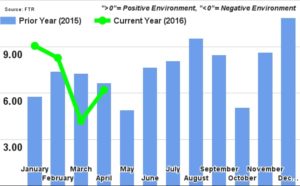 The June 2016 issue of Trucking Update by freight transportation forecasting firm FTR reports the Trucking Conditions Index (TCI) as up, month over month.
The June 2016 issue of Trucking Update by freight transportation forecasting firm FTR reports the Trucking Conditions Index (TCI) as up, month over month.
According to FTR the (TCI) for April measured a 6.2 reading, but while up month over month, reflects soft market conditions affecting the trucking sector.
FTR is currently forecasting a transition to moderate growth toward the end of the year, but sees some downside risk that freight could slow further. FTR does not expect any freight-driven capacity restraints on the sector over the next several years. Those are only likely to come from regulatory action, FTR said in a press release regarding its latest findings.
FTR’s Chief Operating Officer Jonathan Starks says in the press release, “There is enough uncertainty swirling around the trucking markets right now to force a manager or business owner to keep the antacids handy. Spot market rates are still negative, contracts rates are moving in that direction, and freight growth has stalled out for several segments. Luckily, not all of the news is bad. The driver shortage is no longer the immediate concern it once was, and the economy continues to trudge along. I am watching inventory right now because of its quick impact on freight demand. Inventory levels are at highs that we haven’t seen outside of a recession since the turn of the 21st century. Does that mean we are heading into a recession? Perhaps, but not definitively. The other conclusion is that higher inventory is the new norm, and it’s just going to take some time for supply chains to optimize their inventories. That could slow freight growth but wouldn’t put the brakes on truck demand.”
Trucking Update, published monthly, is part of FTR’s Freight Focus and reports data that directly impacts the activity and profitability of truck fleets. As part of Trucking Update, FTR forecasts expected trends in this data and the probable short and long term consequences.
